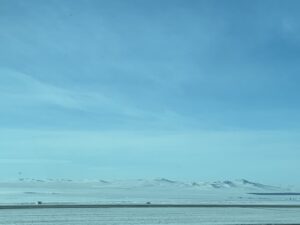Like in many other places in the world, the country of Mongolia is endeavoring to move away from coal.
And it is trying to be both practical and realistic.
There are not many people in Mongolia, just 3.3 million for an area that stretches to 1.56 million square kilometers. People are spread pretty thinly over the country except for its one large city of 1.6 million. And therein lies the problem.
As you might imagine it gets pretty cold in Mongolia and the country is replete with coal. Thus, it is of no surprise that this is what is used to heat most of Ulaanbaatar and during the winter and the air is some of the most polluted in the world (Soyol-Erdene et al., 2021; Sumiya et al., 2023).
I arrived last mid-November to give workshops on coalbed methane; the government has an initiative to replace coal with as much gas as possible as a transition to more renewable energy. They know the journey entails gas; when your winters are -40ºC you can’t just flip a switch, there has to be a transition.
Arriving at 3am and making the 45 min drive from the airport into the city, without knowing why at first, I started thinking of eastern Kentucky and my days of doing geology there. It took a few seconds but I soon realized why: that same smell of of high sulphur coal being burned.
 There are also geopolitical reasons why Mongolia would like to be energy independent. Looking at a map gives you the very visible reason.
There are also geopolitical reasons why Mongolia would like to be energy independent. Looking at a map gives you the very visible reason.
Previously, I had helped assess the amount of natural gas that is held in Mongolia’s coal and it is a lot (Moore et al., 2022; https://www.ciphercoal.com/coalbed-gas-resources-of-mongolia-cipher-amep-mrpam-ngs-finish-assessment-and-hold-workshops-in-ulaanbaatar/).
There substantial more exploration and engineering that needs to be done before resources are realized as reserves and then produced, but it can be done if there is proper technical and commercial understanding by both private and governmental organisations.
My workshops were setting the scene about the character of coal; how and why it produces gas and where in the depositional sequence you can find these wonderful organic deposits*. I gave multi-day presentations to both private companies and governmental organisations.
Some of the specific discussions surrounded how other countries have regulated coalbed methane development, especially that of Australia.
I look forward to continuing to discover the beauty of Mongolia and also assist in its transition from a coal energy producer to gas and beyond.
*part of my work also involves using these fantastic deposits to learn about past palaeoclimates and palaeoecologies. See some of my previous blogs publications on the Early Cretaceous palaeomires of Inner Mongolia, China.
Moore, T.A., Bat-Orshikh, E., Otgon, M., Friederich, M.C., Dovchintseren, D., Morris, R.D., Batsukh, K., Nelson, C.R., 2022. Coalbed methane resources of Mongolia. Australia Mongolia Extractive Program 2, 206 pp, Ulaanbaatar, Mongolia.
Soyol-Erdene, T.-O., Ganbat, G., Baldorj, B., 2021. Urban air quality studies in Mongolia: Pollution characteristics and future research needs. Aerosol and Air Quality Research 21, 210163, 22 pp., https://doi.org/10.4209/aaqr.210163.
Sumiya, E., Dorligjav, S., Purevtseren, M., Gombodorj, G., Byamba-Ochir, M., Dugerjav, O., Sugar, M., Batsuuri, B., Tsegmid, B., 2023. Climate patterns affecting cold season air pollution of Ulaanbaatar City, Mongolia. Climate 11, 4, 22 pp, https://doi.org/10.3390/cli11010004.




Comments are closed.